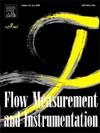Impact of vegetation cover on the hydraulic characteristics of rectangular and rounded broad-crested weirs
IF 2.3
3区 工程技术
Q2 ENGINEERING, MECHANICAL
引用次数: 0
Abstract
The hydraulic characteristics of rectangular and rounded broad-crested weirs covered by flexible vegetation were studied in a laboratory flume. Free-surface and velocity profiles were measured for a range of upstream head relative to weir crest lengths 0.075 < H/L < 1.3 and equivalent vegetation roughness heights 18 mm < ks < 318 mm. The results demonstrated significant differences in hydraulic performance between the smooth- and vegetated-crested weirs. The effect of vegetation roughness on discharge reduction was reflected by the boundary shear stress on the weir crest. Analysis of the discharge coefficient data suggested that flow over vegetated-crested weirs with different vegetation cover densities can be classified into broad-crested weir flow for 0.1 < H/L < 0.4 and narrow-crested weir flow for 0.4 < H/L < 1.3. The flow discharge coefficient increased with increasing H/L, H/(H + P), and H/ks. Two formulae were proposed to predict the flow discharge coefficient correction over vegetated-crested weirs with different crest lengths and heights, for both rectangular and rounded crested weirs.
求助全文
约1分钟内获得全文
求助全文
来源期刊

Flow Measurement and Instrumentation
工程技术-工程:机械
CiteScore
4.30
自引率
13.60%
发文量
123
审稿时长
6 months
期刊介绍:
Flow Measurement and Instrumentation is dedicated to disseminating the latest research results on all aspects of flow measurement, in both closed conduits and open channels. The design of flow measurement systems involves a wide variety of multidisciplinary activities including modelling the flow sensor, the fluid flow and the sensor/fluid interactions through the use of computation techniques; the development of advanced transducer systems and their associated signal processing and the laboratory and field assessment of the overall system under ideal and disturbed conditions.
FMI is the essential forum for critical information exchange, and contributions are particularly encouraged in the following areas of interest:
Modelling: the application of mathematical and computational modelling to the interaction of fluid dynamics with flowmeters, including flowmeter behaviour, improved flowmeter design and installation problems. Application of CAD/CAE techniques to flowmeter modelling are eligible.
Design and development: the detailed design of the flowmeter head and/or signal processing aspects of novel flowmeters. Emphasis is given to papers identifying new sensor configurations, multisensor flow measurement systems, non-intrusive flow metering techniques and the application of microelectronic techniques in smart or intelligent systems.
Calibration techniques: including descriptions of new or existing calibration facilities and techniques, calibration data from different flowmeter types, and calibration intercomparison data from different laboratories.
Installation effect data: dealing with the effects of non-ideal flow conditions on flowmeters. Papers combining a theoretical understanding of flowmeter behaviour with experimental work are particularly welcome.
 求助内容:
求助内容: 应助结果提醒方式:
应助结果提醒方式:


